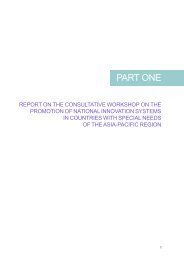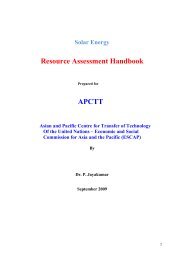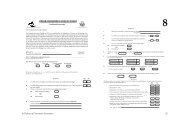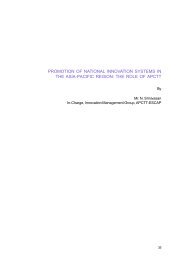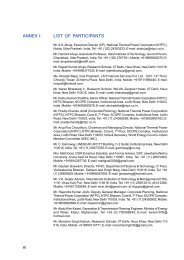•Foreign investment comprising FDI and portfolio investment represents non-debt liabilitieswhile loans – external assistance, external commercial borrowings (ECBs) and tradecredit – and banking capital including deposits are debt liabilities. In India, FDI ispreferred over portfolio growth as the FDI growth tends to be more stable than portfolioand other forms of capital growth. Rupee denominating debt is preferred over foreigncurrency debt, and medium- and long-term debt is preferred over short-term debt.Since 2000, significant changes have been made in the FDI policy regime by thegovernment to ensure that India becomes an increasingly attractive and investor-friendlydestination.The current phase of FDI policy is characterized by negative listing, which permits FDIfreely in all sectors except a few sectors indicated through a negative list. Under thecurrent policy regime, there are three broad entry options for FDIs. In a few sectors,FDI is not permitted (negative list); in another small category of sectors, foreigninvestment is permitted only till a specified level of foreign equity participation; and thethird category, comprising all the other sectors, where foreign investment up to 100 percent of equity participation is allowed.The third category has two subsets – one consisting of sectors where automatic approvalis granted for FDI (often foreign equity participation less than 100 per cent) and theother consisting of sectors where prior approval from the Foreign Investment ApprovalBoard (FIAB) is required. FDI policy changes increasingly reflect the requirements ofindustry and are based on stakeholders’ consultation. Upfront listing of negative sectorshas helped focus on reform areas, which are reflected in buoyant FDI inflows.The cumulative amount of FDI inflows from April 2000 to December 2011 stood atUS$240.06 billion, out of which FDI equity inflows amounted to US$157.97 billion asshown in Table 2-3. FDI inflows declined globally in 2009 and 2010. While India wasable to insulate itself from the decline in global inflows in 2009-10, FDI flows moderatedin 2010-11.Table 2-3: FDI inflows into IndiaFinancial Year As per international Growth FDI equity inflows Growthpractices (US$ billion)* (US$ billion)# (per cent) (per cent)2003-04 4.32 -14 2.19 -192004-05 6.05 +40 3.22 +472005-06 8.96 +48 5.54 +722006-07 22.83 +146 12.49 +1252007-08 34.84 +53 24.58 +972008-09 (P) 41.87 +20 27.33 +112009-10 (P) 37.75 -10 25.83 -52010-11 (P) 32.90 -13 19.43 -252011-12 (April-Dec.) 35.35 24.19April 2000-Dec. 2011 240.06 157.97Notes: * As per Reserve Bank of India estimates;#As per Department of Industrial Policy & Promotion estimates.(Source: Office of the Economic Adviser, DIPP)58
For India to maintain its momentum of GDP growth, it is vital to ensure that therobustness of its FDI inflows is also maintained. FDI inflows rose to US$24.19 billionduring April-December 2011, an increase of 50.8 per cent compared with the correspondingperiod of the previous year.Policy flip-flops, combined with global risk aversion, are prompting foreign companiesto increasingly repatriate their investments out of India during the last three yearsended December 2011 – the figure that was just a few million dollars between 2000 and2008 jumped to US$3.1 billion in 2009 and further to US$10.7 billion in 2011, accordingto Nomura, a global financial power house. Although total FDI flows are still in the positiveterritory, estimated at about US$20 billion for the year 2011-12, increasing FDI debtcould turn out to be, among other issues, another drag on the strength of the rupee.2. FDI projectsIndia attracts a variety of investments from all regions of the world, but more than half(51 per cent) from the United States, Germany, the United Kingdom and France. Thetotal value of FDI was US$58,261 million in the year 2011. India is the fourth destinationcountry in terms of projects, behind the United States (first), China (second) and theUnited Kingdom (third). However, in terms of FDI value, India is the third destinationbehind China (first) and Brazil (second). FDI projects increased by 20 per cent in Indiain 2011, attracting 932 projects, which created an estimated 255,416 jobs.Ernst & Young Consulting conducted a 2012 India Attractiveness Survey, which observedthat regardless of present economic crisis, the strong increase in the number of FDIprojects in India is a clear indication that global investors view the country as aneffective investment destination. More than half of the respondents remained convincedabout India’s long-term prospects and planned to strengthen their operations in thecountry, and more than two-thirds of those interested in India were planning to implementprojects in the short term. The Survey report held that manufacturing is likely to play aleading role in India’s future growth trajectory, as the country is rapidly emerging as amanufacturing location for many foreign corporations.India’s FDI activity is specialized on large industrial and back-office operations. In2011, the country received 288 large-scale manufacturing projects, creating an estimated142,235 new jobs, mostly in the automotive, industrial equipment and metals industries.India also received 238 large back-office and business process outsourcing (BPO)projects creating 30,269 new jobs, mainly in the information technology (IT) servicesindustry.3. TechnologyThe technology sector in India has a major impact on the Indian economy. The industryhas grown from US$4 billion in 1998 to more than US$80 billion in 2011, employingdirectly and indirectly more than 10 million people. Riding on the services outsourcingway, domestic and international companies have leveraged India’s value proposition toenhance their competitiveness in the global market.The technology sector in India received US$6.2 billion through FDI in 2011. Thisinvestment has created 153 projects with an estimated 41,607 jobs in the industry.59
- Page 1 and 2:
ADVANCES IN FOSSIL FUELTECHNOLOGIES
- Page 3 and 4:
ADVANCES IN FOSSIL FUELTECHNOLOGIES
- Page 5 and 6:
CONTENTSABBREVIATIONSiiiPART ONEREP
- Page 7 and 8:
ABBREVIATIONSAC : Alternating curre
- Page 9:
OECD : Organization for Economic Co
- Page 12 and 13:
IORGANIZATION OF THE WORKSHOPA. Bac
- Page 14 and 15:
D. Election of officersThe followin
- Page 16 and 17:
IIICONSIDERATION OF ISSUESA. Backgr
- Page 18 and 19: emissions. Underground coal gasific
- Page 20 and 21: 800 MWe, a steam pressure of 300 kg
- Page 22 and 23: • Materials development & manufac
- Page 24 and 25: Figure 1-5: Strategy for commercial
- Page 26 and 27: tonnes, the state-owned enterprise
- Page 28 and 29: • Ensuring not just easy FDI entr
- Page 30 and 31: MW ultra-supercritical units; and s
- Page 32 and 33: the captive generation capacity) on
- Page 34 and 35: and other financial institutions -
- Page 36 and 37: and higher efficiency power generat
- Page 38 and 39: energy technologies, which can enab
- Page 40 and 41: • Such massive financial inputs c
- Page 43 and 44: BASELINE REPORT ON FOSSIL FUEL TECH
- Page 45 and 46: B. General R&D climate in the count
- Page 47 and 48: a convenient way to envisage energy
- Page 49 and 50: to mature and become more cost-comp
- Page 51 and 52: emissions, at least relative to sin
- Page 53 and 54: The Ministry of Power (MoP), which
- Page 55 and 56: 3. Bio-energyBio-energy, widely ava
- Page 57 and 58: in such a canal will rotate at a lo
- Page 59 and 60: in tackling climate change. A one p
- Page 61 and 62: Advantages of supercritical plants
- Page 63 and 64: existing power plants but also to b
- Page 65 and 66: BASELINE REPORT ON FOREIGN DIRECT I
- Page 67: CEA at 598 mt. This is mainly due t
- Page 71 and 72: Table 2-5: Electricity generation t
- Page 73 and 74: Growth, which submitted its interim
- Page 75 and 76: 3. Future challengesThe future chal
- Page 77 and 78: development worked out. Public-priv
- Page 79 and 80: Linking FDI to technology transferI
- Page 81 and 82: The total requirement of fund durin
- Page 83 and 84: Funding from multilateral agenciesM
- Page 85 and 86: cooperation will be essential in so
- Page 87: Planning Commission, Government of
- Page 90 and 91: ANNEX I:LIST OF PARTICIPANTSMr. A.K
- Page 92 and 93: Mr. S.C. Shrivastava, Joint Chief (
- Page 94 and 95: ANNEX II:PROGRAMME6 June 2012, Wedn
- Page 96 and 97: ANNEX III:AN OVERVIEW OF ADVANCED F
- Page 98 and 99: • Technology solutions are also v
- Page 100 and 101: Table 3-5: Improvement in cycle eff
- Page 102 and 103: • No liquid effluent formation;
- Page 104 and 105: Figure 3-5: Advancement of gas turb
- Page 106 and 107: Figure 3-8: Goal 2 - New clean tech
- Page 108 and 109: Compared with conventional power pl
- Page 110 and 111: Figure 3-14: Thermax coal gasificat
- Page 112 and 113: ANNEX VII:GE ENERGY AND ADVANCED FO
- Page 114 and 115: ANNEX VIII:SWOT ANALYSIS OF FOSSIL
- Page 116 and 117: By 2035, cumulative CO 2emissions f
- Page 118 and 119:
• Falling prices of renewable ene
- Page 120 and 121:
Figure 3-20: New advanced coal powe
- Page 122 and 123:
ANNEX X:ENERGY CONSERVATION: ERDA
- Page 124 and 125:
Table 3-11: Energy cost and intensi
- Page 126 and 127:
300Figure 3-23: Trends in coal use
- Page 128 and 129:
C. Gaps in coal use efficiencyFigur
- Page 130 and 131:
ANNEX XII:FINANCING OF THE POWER SE
- Page 132 and 133:
With the entry of many private sect
- Page 134 and 135:
for future requirements should be t
- Page 136 and 137:
Short supply of coal has started af
- Page 138:
Figure 3-35: Life-cycle of technolo



